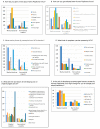Awareness of Human Papillomavirus and Its Oncogenic Potential in Head and Neck Cancer among Students: Still More Questions than Answers
- PMID: 33266390
- PMCID: PMC7700204
- DOI: 10.3390/ijerph17228667
Awareness of Human Papillomavirus and Its Oncogenic Potential in Head and Neck Cancer among Students: Still More Questions than Answers
Abstract
In the past years, human papilloma virus (HPV) has been proved to be an important risk factor for head and neck squamous cell carcinomas (HNSCCs), especially in the oropharynx (OPCCS). The aim of this study was to assess the level of knowledge about HPV among students and to raise their awareness on the issue. A 22-question questionnaire was uploaded to an online service. Information about the project was sent out to students from three Universities in Lodz, Poland. All data were collected via questionnaire website tools. A total of 1710 students participated in this study. The group was divided into medical (MS) and non-medical (non-MS) students. Merely 59.38% of the non-MS had ever heard about HPV. Only 44.74% of the non-MS knew about vaccines against HPV. The oncogenic potential of HPV was evident for 81.17% of the MS and only 55.92% of the non-MS. Very similar numbers of respondents from both groups (39.21% vs. 36.47%) knew that HPV may cause cancers other than cervical. Nearly half of the respondents from both groups (46.28% vs. 48.32%) did not know about the risk of developing oral or oropharyngeal cancer. The level of knowledge about the consequences of HPV infection in head and neck cancers in young adults remains insufficient.
Keywords: awareness; cancer; head and neck squamous cell carcinoma; human papilloma virus; student; survey study.
Conflict of interest statement
The authors declare no conflict of interest
Figures


References
-
- Ferlay J., Ervik M., Lam F., Colombet M., Mery L., Piñeros M., Znaor A., Soerjomataram I., Bray F. Global Cancer Observatory: Cancer Today. International Agency for Research on Cancer; Lyon, France: 2018. [(accessed on 1 March 2019)]. Available online: https://gco.iarc.fr/today.
-
- Zur Hausen H. Intracellular surveillance of persisting viral infections. Human genital cancer results from deficient cellular control of papillomavirus gene expression. Lancet. 1986;2:489–491. - PubMed
MeSH terms
Substances
LinkOut - more resources
Full Text Sources
Medical
Miscellaneous

